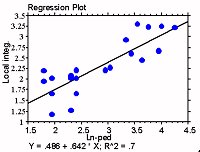
 |
||||
| Also available as an Acrobat File | 

|
|
|
Visualisation in the Social Sciences WorkshopShow and TellBin Jiang | |
Advanced Visualisation and Virtual Reality for Exploring Complex Social PhenomenaSummaryThis demo is trying to show how advanced visualisation and virtual reality are used for exploring the complex social phenomena, i.e. using multi-agent simulation to simulate human social activities in urban systems. The basic hypothesis behind the simulation is that whether urban morphological structure has some impact on human social activities. It has been proven in space syntax (Hillier and Hanson 1984) that there is a relationship between urban morphological structure and the social activities. Here with advanced visualisation and virtual reality, the hypothesis is re-examined in a virtual urban environment. In this submission, we show a snapshot of the simulation and a short explanation, but we will bring our computer for a live demo in the 'show and tell' session.Graphics A snapshot of the simulation for pedestrian crowds Multi-agent simulationDrogoul and Ferber (1994) have summarised multi-agent simulation as a set of the following elements: agents, behaviours, objects, environment and communications. Four of them are described by the quadruplet:>agents, objects, environment, communications< where agents is the set of all the simulated individuals, and behaviours are properties of agents; objects is the set of all represented passive entities that do not react to stimuli(e.g. buildings, street furniture in urban environments); environment is the topological space where agents and objects are located, where they can move and act, and where signals (sounds, smell, etc.) propagate; and communications is the set of all communication categories, such as voice, written materials, signs, etc. An exampleA virtual urban environment is constructed with the four classes of objects: agents are named as red people with the behaviour of speed, heading and movement; objects are churches, hotels, monuments, post offices etc.; the physical urban space looks rather regular consisting 21 streets whose morphological properties are described by space syntax (Hillier and Hanson 1984);Table 1: Instances set in the example | ||
| Classes | Instances | |
|---|---|---|
| Agents | red people behaviour: speed (up | down) heading (0 - 360) movement (forward | backward) | |
| Objects | church, hotel, monument, post office, school, library, park etc. | |
| Environments | urban space with 21 streets as in figure 1 | |
| Communications | between red people between red people and the urban space | |
| The simulation consists of two parts, as you can see in the above figure. The right hand is an urban space, within which pedestrians are pictured as red. The left hand is the control panel. The setup button creates the number ( as shown in scale bar named as number) of red people walking in the urban space. The walk button keeps all red people continuously moving around, and counts the number of pedestrians per time unit in each street, as shown in the monitor tools. | ||
The result
ReferencesDrogoul A. and Ferber J. (1994), Multi-agent Simulation as a Tool for Studying Emergent Processes in Societies, in Gilbert N. and Doran J. (eds.) Simulating Societies: The Computer Simulation of Social Phenomena, University College London Press: LondonHillier B. and Hanson J. (1984), The Social Logic of Space, Cambridge University Press: Cambridge. Jiang B. (1998), Multi-agent Simulations for Pedestrian Crowds, Submitted for publication. |
||
Contact DetailsBin JiangEmail: b.jiang@ucl.ac.uk Centre for Advanced Spatial Analysis University College London 1-19 Torrington Place, London WC1E 6BT, UK Tel: +44 171 391 1255, Fax: +44 171 813 2843 |
||
Graphics Multimedia Virtual Environments Visualisation Contents